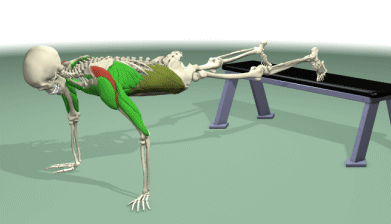




THE FITNESS
DIGEST.
Types of Pushups
Pushups are a popular body-weight exercise that can be performed just about anywhere. Pushups are an effective way to work your upper body, but they can often lead to stale workouts and boredom. However, there are different types of pushups that work similar muscle groups while allowing for variety in your exercise routine.
Standard Pushup
Standard pushups work the pectoralis major, anterior deltoids, serratus anterior and triceps brachii. Your back, abdominal and gluteal muscles are also used to stabilize your torso and hips throughout the exercise. To perform a pushup, support yourself face down on the floor with your arms extended, hands shoulder-width apart and your feet touching or slightly apart. Inhale and bend your elbows to bring your chest to the ground while keeping your body in a straight line. Push back up to extend your arms, exhaling at the end of the movement.
Incline Pushup
Incline pushups work the same muscle groups as the standard pushup, but by elevating your chest, the inferior part of the pectoralis major is targeted more intensely. Perform an incline pushup by placing your hands on a sturdy object that is 6 to 18 inches off the ground and then complete the pushup movement.
Decline Pushup
The decline pushup is accomplished by elevating your feet on a platform 6 to 18 inches high. This type of pushup isolates the upper part of the pectoralis muscle.
Wide-Stance Pushup
To work the outer portions of your chest muscle, utilize the wide-stance pushup. Simply place your hands wider than your shoulders when performing a pushup.
Narrow-Stance Pushup
The narrow stance pushup is done by placing your hands narrower than your shoulders. This pushup variation isolates the inner part of the pectoralis muscle and also intensely works your triceps. An extreme version of this pushup is the diamond pushup, in which you form a diamond shape with your index fingers and thumbs. Keep your hands in this position, then lower your chest toward your hands. The narrow-stance pushup can also be done by placing your hands on a small medicine ball instead of the floor.
Plyometric Pushup
Plyometric pushups are challenging. The muscles of the chest, arms and back are worked in an explosive and powerful manner. Begin in pushup position with your hands on a small medicine ball and your arms extended. Quickly remove your hands from the ball and drop down so your hands contact the floor shoulder-width apart and your elbows are slightly flexed. Allow your chest to almost touch the medicine ball as your elbows bend. Immediately and explosively push up by extending your elbows. Quickly place your hands back on the ball and repeat the exercise. To increase the intensity, use a larger ball.
Deficit Pushup
The deficit pushup requires a greater range of motion than the standard pushup and is more challenging. This type of pushup targets the same muscle groups as the standard pushup, but also works to stretch the pectoralis major, facilitating chest expansion. Place your hands on small objects such as blocks or small medicine balls that are 4 to 6 inches off the floor. Assume the pushup position, then lower your chest to the floor or at least below the level of your hands. Push your body back to the starting position.
T-Pushup
This pushup variation works the same muscles as the standard pushup, but also targets the obliques and posterior deltoids. Begin a T-pushup in standard position. Lower yourself to the floor, then push your body upward. From the top part of the pushup, lift your left arm straight up into the air by twisting your waist to form a "T." Stabilize your torso and hold the position for a count of two, then return to pushup position. Complete another pushup, then twist to lift your right arm into the air. Hold the "T," then lower back down. Continue to alternate arms. You can increase the difficulty by holding a dumbbell in each hand.

Physical fitness Disclaimer and Waiver of liability:
Exercises are not without their risks and the exercise programs in this website may result in injuries.Any person who undertakes these exercises does so at their own risk.To reduce the risk of injuries ,you should consult your doctor before beginning these or any other exercise programs.As with any exercise program ,if at any point during your workout you believe conditions to be unsafe or begin to feel faint or dizzy,have physical discomfort or pain, you should stop immediately and consult a physician.
Daily exercise for Working women.
Jumping Jacks. . Effective workouts.
Group exercise and its benefits.
Calf raises-free style . Push ups.
Tummy exercises. Hoola Hooping .
Fitness Motivational tips. Barbell Squauts.
The myths of spot reduction. Leg press.
Standing calf raises. Concentration curls.
Bench (Tricep) dips.. One arm dumbbell rows.
Pec deck Flye. Fr0nt dumbbell raises. Glute ham raise.
Seated leg curl . Close grip bench press .
.

Please keep comments positive and constructive.
Help the WEBSITE by reporting inappropriate comments to thefitnessdigest@gmail.com . Inappropriate comments may be reported and/or removed.